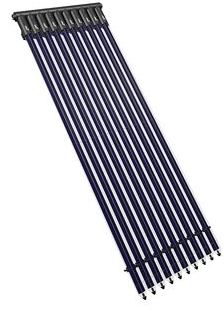Individual solar water heater: heat water with free energy
Is the price increase in electricity bills making you dizzy? Do you want to secure your expenses and the quantity of hot water you can produce, while maintaining your comfort?
If you are looking for more independence, autonomy and resilience, this solution will interest you.
Today, even more than before, it is essential to face uncertainties while contributing to the common effort for this somewhat… “sporty” transition.
The solar water heater uses the only resource that everyone can have for free… the sun!
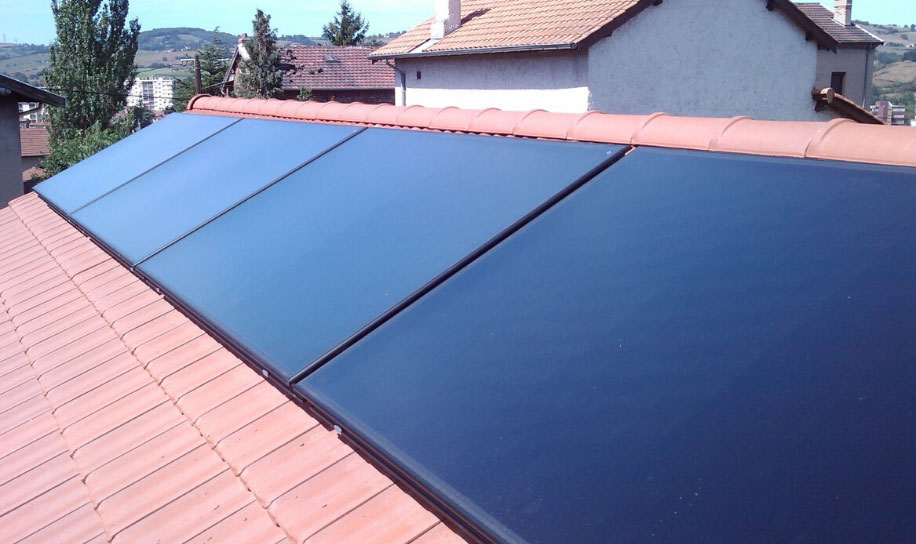
What is a solar water heater?
This is a solar energy recovery system to produce part or all of the domestic hot water for your home. In this specific case, it is CESI: Individual Solar Water Heater.
CESI can provide 50 to 70% of domestic hot water needs while reducing the energy bill. Solar thermal partially or completely replaces other energy sources such as electricity, gas, fuel oil, biomass, etc.
It is made up of three main elements:
- Thermal solar panels (also called collectors ): they are installed on your roof to capture the sun's rays.

- The solar tank (or cumulus) : equipped with a heat exchanger, it ensures the transfer of calories between the fluid heated by the sun and the domestic water in the tank.
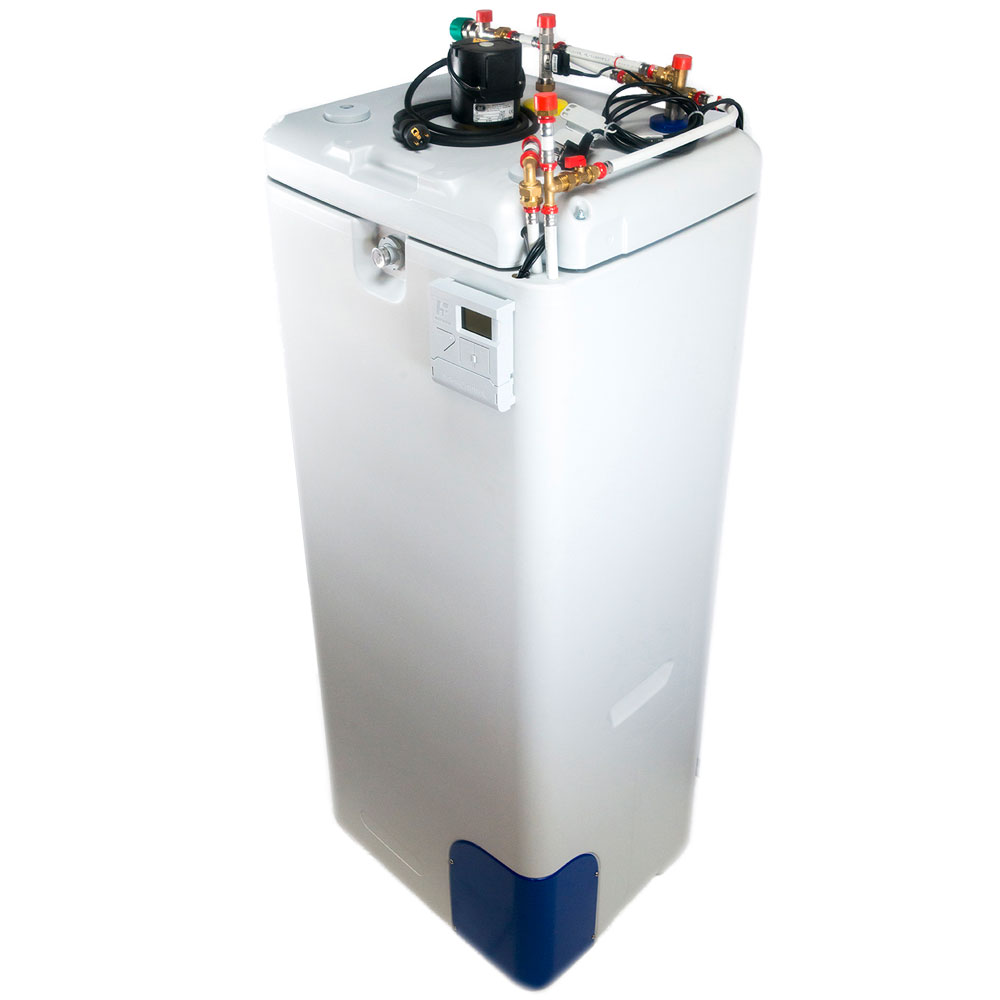
- Supplementary heating : to ensure hot water production all year round and whatever the weather, an electrical resistance generally takes over in the absence of radiation. This additional heating can also be provided by a heat pump (PAC), a gas, wood or oil boiler.
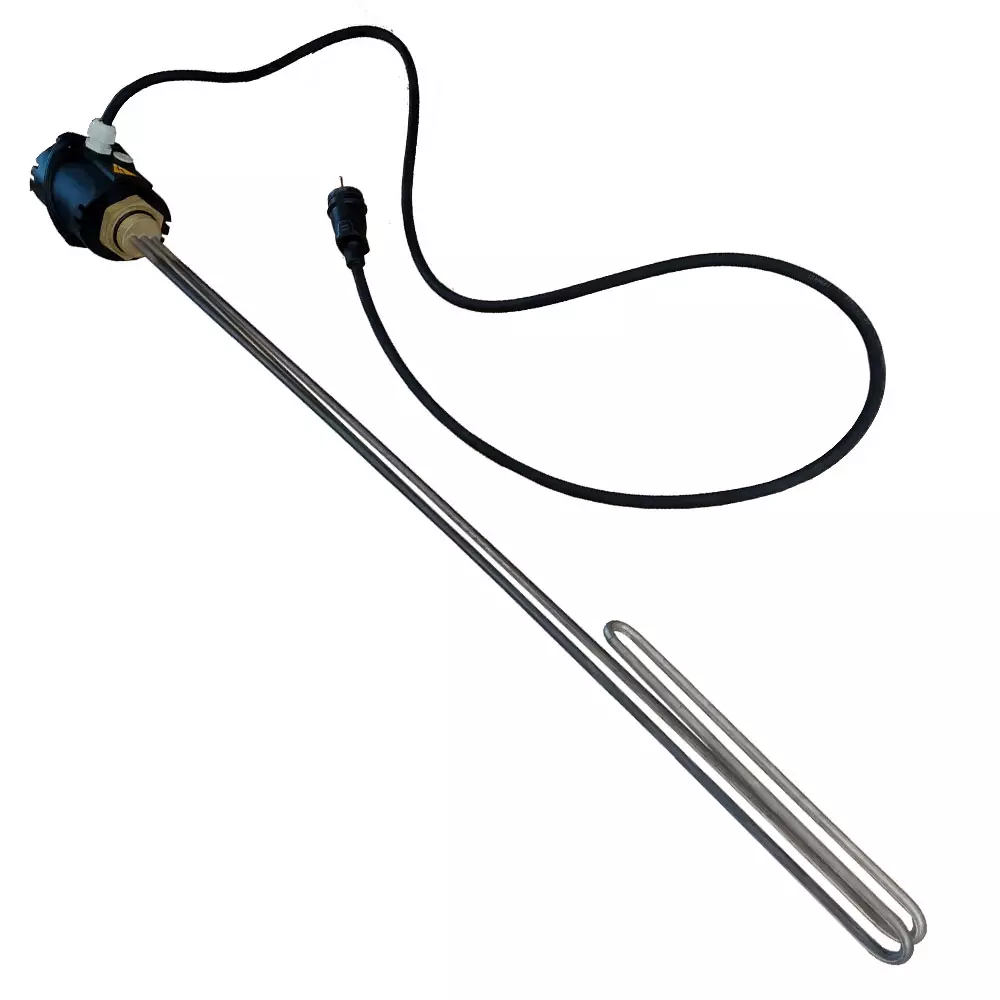
Other elements may be necessary depending on the type of installation chosen such as the circulator, the expansion tank, the regulation. If you are in the Lyon region, we have solar balloons in stock in Rillieux-la-Pape .
How does a solar water heater work?
Solar collectors transform solar energy , more precisely solar radiation, into thermal energy . That is to say that they will transmit heat and not electricity (as a reminder, electricity is produced using a photovoltaic panel).
This heat is transferred from the sensors to the tank thanks to a heat transfer fluid (= which transports the heat) which circulates in copper or stainless steel or multilayer tubes.
The heat transfer liquid then passes through an exchanger located at the bottom of the hot water tank and will transmit its calories to the domestic water.
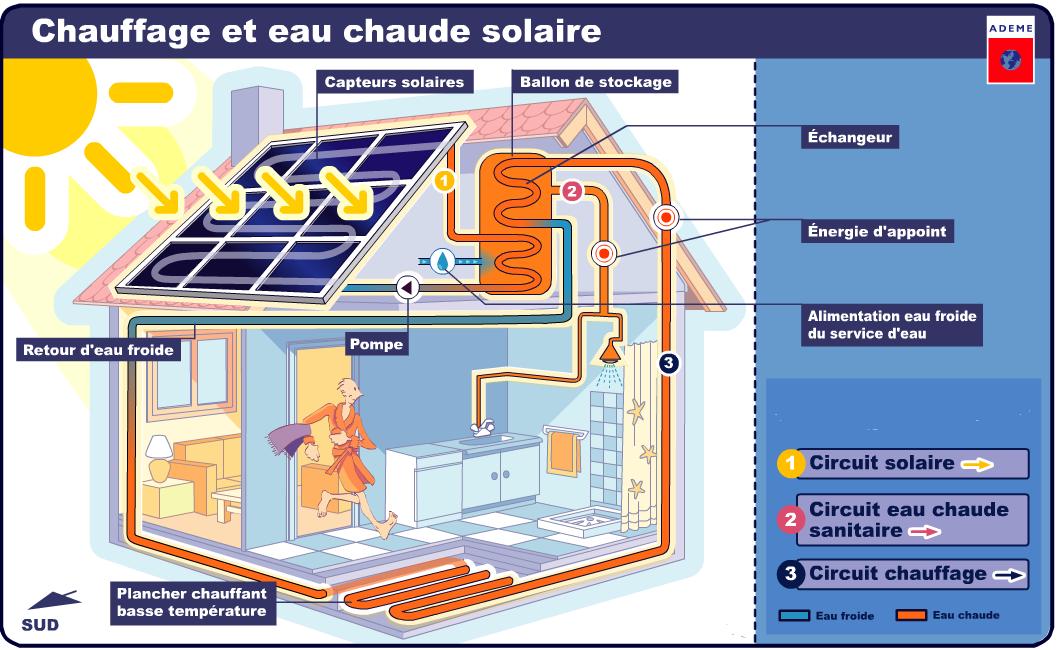
@source ADEME
By transmitting heat into the tank, the heat transfer liquid remains in motion and cools while the water heats up. It then returns to the solar thermal collectors to start a new heating cycle.
The heated water from the tank is then used by the fireplace in the bathroom or kitchen.
rite; encrypted-media; gyroscope; picture-in-picture" allowfullscreen="" frameborder="0" height="472" src="https://www.youtube.com/embed/UsDls0K6jLU" title="YouTube video player" width="840">
Advantages and disadvantages of solar heating system
Advantages of an individual solar water heater
- Use of truly renewable , free , ecological and unlimitedly available energy,
- Reliability : 20 to 30 years for the sensors and the solar cumulus
- An increasingly rapid return on investment given the increase in the price of fossil fuels such as gas or electricity.
Disadvantages of an individual solar water heater
- Solar contribution varies during the day and throughout the seasons, since it depends on the amount of sunshine. It is therefore necessary to provide an additional device to meet your needs in all circumstances and to compensate when the sunshine is insufficient.
- The investment for this type of installation will be higher than more conventional installations (electric cumulus or thermodynamic balloon). Note that you can benefit from state aid such as My Renov bonus.
- Installing a system of solar panels and a tank requires having enough space to do so, outdoors and indoors.
The different types of solar collectors
To understand what a solar water heater is and how it works, you need to know that there are several types of solar water heating systems and that there are also different types of sensors.
The choice of this key element will depend on the temperature with which you wish to work, the price or availability.
Flat or glass sensor
This is the most common sensor model. It appears in the form of thick panels (around 90 mm). It is a kind of thermally insulated box covered with glazing. The surface area of a sensor varies depending on the manufacturer, but they are generally 1.5 to 2.5 m².
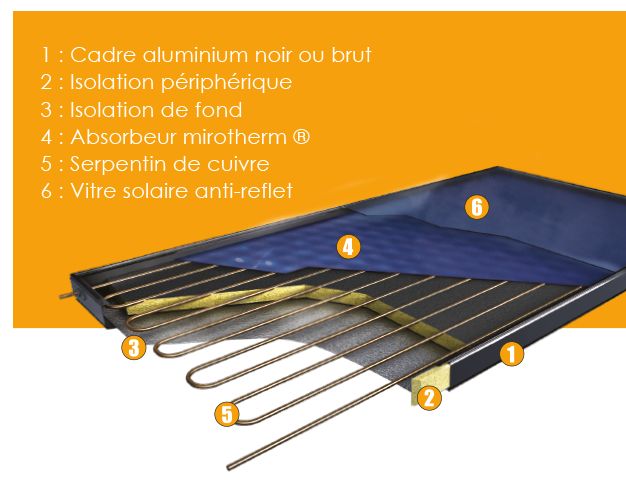
Inside, a pipe filled with the heat transfer fluid snakes across the entire surface of the sensor. It is placed on insulation to retain the heat recovered as much as possible. It is covered by a dark metal plate (the absorber) to capture the maximum amount of solar energy.
The aluminum frame ensures the rigidity of the sensor and the glass allows light rays to pass through while keeping the interior of the sensor waterproof.
Fields of application : these sensors can be used for individual or collective solar water heaters as well as for combined solar systems (SSC) which also produce heating water for the home.
Vacuum sensor
They appear as black tubes connected together by holding bars.
The heat transfer fluid circulates inside a double vacuum tube tinted black (aluminum nitride), which absorbs the sun's rays.
The sun's rays come directly onto the tube or indirectly by reflection thanks to the contribution of the background parabolic mirrors.
The vacuum tube has better insulation than the flat collector, which gives 30% higher efficiency in winter. For the rest of the year, it is equivalent.
On the other hand, these sensors are more complicated to produce, which increases the production cost.
Scope of application : evacuated tubes are also used for individual or collective solar water heaters as well as for combined solar systems (SSC), but also in certain industrial applications.
Carpet sensor
It is made of very resistant soft rubber in which water circulates. This system is less specific technologically speaking, and is therefore the least expensive of all. However, it is not efficient enough to heat domestic hot water, unless you are in a hot country.
Scope of application : the carpet sensor is mainly used to heat swimming pool water. It can also be used tothe production of domestic hot water in hot regions.
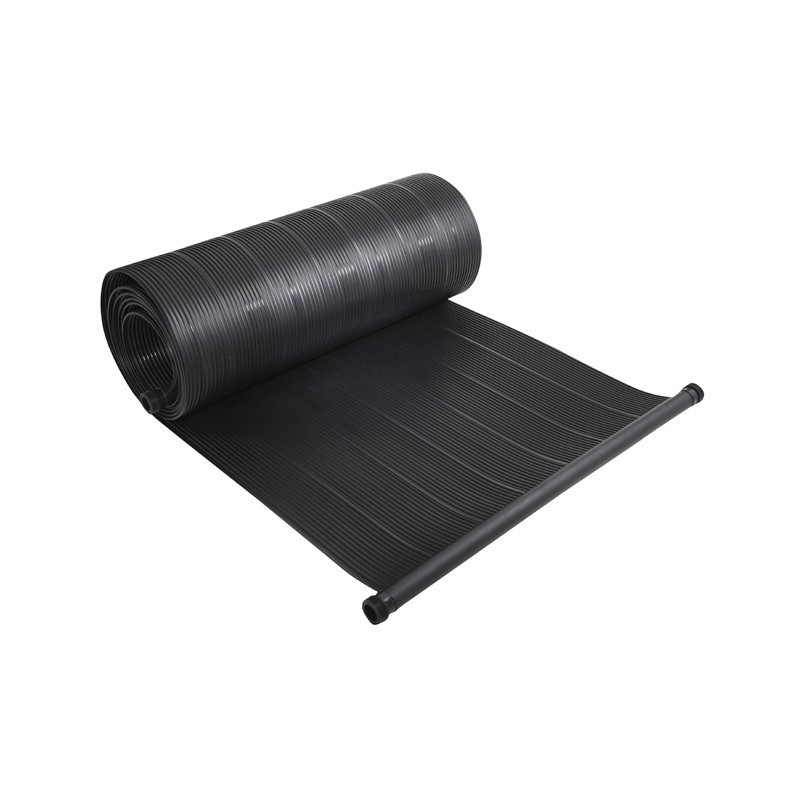 source: Astrapool
source: Astrapool
Operation of solar water heaters (CESI)
There are at least 3 types of solar thermal water heating systems:
CESI under pressure
Historical system, it is the most widely used, present among all manufacturers, adaptable to all situations. The heat transfer fluid is water to which “glycol” has been added for its antifreeze qualities and excellent heat transmission.
This will not drain and that is its limit. Indeed, when the pump is stopped (tank temperature at 85°C / power cut), the glycol heat transfer liquid remains in the sensors and will rise in temperature. It can then overheat and deteriorate.
To counter this effect and maintain the efficiency of the system, it will therefore be necessary to maintain it regularly, in particular by replacing the heat transfer fluid.
CESI Thermosiphon
This is the simplest and most common system in geographic areas that are not subject to frost.
The tank is located above the sensors, on the roof or in the attic. They must be close to the ball. The heat transfer fluid which heats up in the collectors naturally rises in the tank and pushes the colder fluid towards the collector. No need for a circulator or expensive regulation. However, we can find the same problems linked to overheating as CESI under pressure.
Self-draining CESI
The self-draining CESI aims to eliminate the effects of overheating of the sensors in summer. The objective is to empty them of their fluid when there are no calories to recover (when the sensors are too cold or the balloon has reached its maximum temperature). This installation assumes that the sensors are installed higher than the tank and that the solar connection has a continuous slope so that the fluid can flow well.
The maintenance load is then greatly reduced and the installation will gain in longevity.
Self-draining solutions are less well known, because they are not offered by all manufacturers.
- There are glycolated self-draining solutions which require a small drain reserve next to the tank to store the heat transfer fluid.
- There are also very specific self-draining CESI solutions with water to push the simplicity of implementation and use to its maximum (ROTEX, HELIOFRANCE). These solutions are possible: manufacturers have developed a polypropylene balloon model which does not fear corrosion and remains open to atmospheric pressure.
The self-draining solution is preferred when the installation configuration allows it. Otherwise, the pressure solution will be the most appropriate.
How much does it cost to install a solar water heater?
Count on 4,000 to 7,000 euros , with installation for a kit with a 200 to 300 liter tank, coupled with 3 to 5 m² of sensors.
This generally corresponds to the needs of a family. Prices vary depending on the size of the installation: size of the balloon and surface area of the panels.
A price which can vary significantly depending on the installers and the type of solar water heater selected. This type of energy improvement is part of the resilience plan: find out your eligibility and the amount of Ma Prime Renov assistance.
Profitability
The return on investment for a solar hot water production installation is 10 to 15 years on average.
You must also consider that you are improving your energy autonomy.
Indeed, it is interesting not to stop only at financial calculations, as economic parameters can change much more quickly than expected.
The lifespan of the elements is relatively long, provided that they are well maintained: a minimum of 10 years for the most fragile components and up to 30 for solar collectors.
2 questions before investing in a solar water heater
Solar contributions
The ideal solution, as you will have understood, is to install the sensors facing south with an inclination of 40-45 degrees. If you have a different slope, your installation will beNo doubt a little less effective but it will still be interesting.
A professional can come to your home to assess the feasibility of your project.
Sun masks
It will be necessary to observe the sun masks. These can disrupt the sunshine of your installation by casting a shadow, reducing the effectiveness of the solar collectors and therefore their performance.
The place where they are going to be installed must be carefully studied.
You will need to check the shadows cast by roof elements, trees, houses or even neighboring buildings.
Prepare the installation of your solar water heater
Mandatory steps to install a solar water heater
To install solar collectors on the roof of your house, you must request authorization from your town hall , whether you are planning a new house or a renovation. In effect, you are changing the exterior appearance of your building.
Find all the conditions on the public service website as well as the page concerning the prior declaration of works .
The town planning documents can be consulted in your municipality and will inform you about the conditions to be respected regarding the appearance of your accommodation.
To make your life easier, you can directly download the form (CERFA 13703-09)
If you are in a classified site, your project must be presented and validated to the Bâtiments de France architect .
Who can install a solar water heater?
To install a solar water heater, we advise you to work with a specialized craftsman (RGE Qualisol training, Réseau Proeco Energie, etc.). Indeed, your craftsman must be aware of the installation of solar thermal collectors, while respecting safety conditions and without jeopardizing the framework and waterproofing of the roof.
Where to place solar collectors?
For the thermal efficiency of your individual solar water heater to be optimal, the ideal solution is to install them on the south face of your roof, with an inclination of 40 to 50° from the horizontal.
Sizing the installation of your solar water heater
It is often recommended to get help to calculate the size of your solar water heater.
Indeed, properly equipped and having the technical understanding codes, it will be necessary to estimate different parameters such as: the inclination of the plane, the orientation, the albedo of the ground, the surface of calculated sensors, the calculated daily needs, the temperature at which the water must be put so, in particular, that it meets health standards depending on the sizing.
In the calculation, we will also take into account the average annual irradiation of your location, the various solar masks, whether close or far away and their incidence depending on the season.
When providing support, the professional has a duty to advise and listen to customer needs. You will then be able to ask the appropriate questions and thus reach the best compromise for your home.
Sizing the tank of your installation
Start by determining the volume of the balloon according to the needs of the household. There is an average of 40 liters/day/person. It is possible to connect the various machines (washing machine, dishwasher, etc.). It is then necessary to determine the need for these devices.
It is interesting to take advantage of this moment to assess whether it is possible to reduce the household's hot water needs using energy-saving shower heads or foamers.
The calculated volume corresponds to the volume heated by the backup in the absence of sun. You will therefore have to multiply this volume by 1.5 to 2 times to obtain the volume of your solar tank.
For a family of 3 to 4 people, we will generally opt for a solar tank of at least 200 liters.
Sizing of solar panels
The capacity of the tank is an important factor for calculating the surface area of the solar collectors.
On average, we consider 1 m² of sensors for 50 to 75 liters of storage. The sensor area is calculated based on the performance of the sensors and the size of the storage volume.
Here are ASDER 's recommendations on the subject:
| Consumption habits of a family of 4 people | Thrifty family | Average consumption | Do not pay attention |
|---|---|---|---|
| DHW at 40°C | 35 liters/day/person | 45 liters/day/person | 70 liters/day/person |
| Recommended sensor surface | 1 panel of 2 m² | 1 panel of 2.5m² | 2 panels of 2 m² |
Please note: The correct sizing will differ depending on your region. In the south, 2 to 3 m² may be enough for a 200 liter tank, while in the north you will need to allow between 4 and 6 m².
In addition to the elements discussed above and if you really want to try your hand at a calculation, INES (National Institute of Solar Energy) has put online free software accessible on the internet, called: “CalSol”.
The latter allows you to calculate the surface area of panels you need, among other things (including the return on investment).
Would it be interesting to oversize?
Oversizing is not recommended for the following reasons:
- A balloon that is too big will cause you to lose space,
- The water will be heated unnecessarily,
- Increased problems with overheating of the sensor field,
- The stagnation of stored water promotes the appearance of bacteria such as Legionnaires' disease, which is very dangerous for human health. Getting rid of it sometimes requires changing your entire system.
- Solar collectors will have lower productivity.
- The return on investment will be less good.
Would it be worth undersizing?
Undersizing the solar tank will inevitably cause you to lose comfort when the days are cloudy.
It is better to undersize the installed sensor surface than to oversize it. The average productivity of the sensors will be higher and you will reduce the investment.
Despite this, the efficiency of the installation or solar coverage rate will be lower.
How long does a solar water heater last?
The lifespan of a solar water heater varies depending on the models and manufacturers from 15 to 20 years. Well maintained, this equipment can even far exceed this duration.
It generally exceeds that of a thermodynamic system, more technological and therefore more fragile and overall with less good control of the installation rules.
Like any technical equipment, maintenance and good upkeep play an essential role in the durability of a solar water heater.
How to maintain your solar water heating system?
System maintenance
If you want your installation to last a long time and have optimal performance, ensuring its proper functioning through regular maintenance is essential.
To do this, it is recommended to:
• Regularly check the pressure levels (heat transfer fluid)
• Look at the insulation of the hydraulic circuit
• Inspect the circulation pump (only in the case of a solar water heater with an electric pump).
• Ensure that the regulation functions correctly
• Plan a visit from a professional every two to three years (some manufacturers offer tracking)
Maintenance of thermal solar panels
As for cleaning the panels, rain should be quite effective.
However, if you live near a source of dust or dirt (factory, trees, smoke, sand, etc.), you will need to wash it regularly.
It is possible to clean the panels yourself with clear, lukewarm water and a non-abrasive sponge when they have cooled (be careful of your safety!).
Particular attention must be paid to rainwater collection rails; nothing should obstruct the flow, as blockages could create hot spots.
What are the brands of French solar water heaters?
- Heliofrance
- Atlantic
- Saunier Duval
- Giordano
Frequently Asked Questions About Solar Water Heater
Who can tell me about financial aid?
Contact a France Renov advisor, they are the most knowledgeable people on the subject.
Solar or thermodynamic water heater?
Advantages of a solar water heater compared to thermodynamic:
- Proven reliability
- Much lower environmental impact in the event of a leak (the thermodynamic water heater uses a refrigerant that is extremely harmful in terms of global warming power)
Disadvantage of a solar water heater compared to thermodynamic:
- Larger initial investment
Can I use an individual solar water heater in the mountains?
This is an excellent solution because:
- sunshine is greater than the lower layers
- More direct radiation
- The reflection of the snow optimizes the radiation
The yields obtained are better than in the plains even though one might think that the temperatures are milder.
For further :
- Request a quote from my colleague Benjamin
- Discover the ADEME file on solar energy to produce heat at home
No posts found
Write a review
